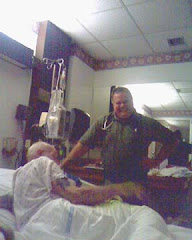2009-February-23rd
Monday 02/23
Myeloproliferative Disorders:
(myelo = bone marrow, proliferative = rapid multiplication), the blood-producing cells in the bone marrow (precursor cells) develop and reproduce excessively or are crowded out by an overgrowth of fibrous tissue. Typically, these disorders are acquired and not inherited, although rarely there are families in which several members have these disorders. It is likely that family members inherit a predisposition to the disorder rather than the disorder itself.
Three major myeloproliferative disorders are polycythemia vera,[myelofibrosis,] and thrombocythemia. The proliferation of blood-producing cells is always noncancerous (benign) when it begins. However, in a small number of people, a myeloproliferative disorder progresses or transforms to a cancerous (malignant) condition, such as leukemia.
Myelofibrosis:
is a disorder in which fibrous tissue replaces the blood-producing cells in the bone marrow, resulting in abnormally shaped red blood cells, anemia, and an enlarged spleen.
Myelodysplastic Syndromes:
In myelodysplastic syndromes, a line of identical cells (clone) develops and occupies the bone marrow. These abnormal cells do not grow and mature normally. The cells also interfere with normal bone marrow function, resulting in deficits of red blood cells, white blood cells, and platelets. In some people, red blood cell production is predominantly affected. Myelodysplastic syndromes occur most often in people older than 50 years. Men are more than twice as likely as women to be affected.
The cause is usually not known. However, in some people, exposure of bone marrow to radiation therapy or certain types of chemotherapy drugs may play a role.
Symptoms develop very slowly. Fatigue, weakness, and other symptoms of anemia are common. Fever due to infections may develop if the number of white blood cells decreases. Easy bruising and abnormal bleeding can result if the number of platelets drops.
A myelodysplastic syndrome may be suspected when people have unexplained persistent anemia, but diagnosis requires a bone marrow biopsy.
People with myelodysplastic syndromes often need transfusions of red blood cells. Platelets are transfused only if people have uncontrolled bleeding, or if surgery is needed and the number of platelets is low. People who have very low numbers of neutrophils—the white blood cells that fight infection—may benefit from intermittent injections of a special type of protein called a colony-stimulating factor.
Although myelodysplastic syndromes are thought to be a type of leukemia, they progress gradually, over a period of several months to years. In 10 to 30% of people, a myelodysplastic syndrome transforms into acute myelocytic leukemia (AML). Treatment with chemotherapy during the early stages of a myelodysplastic syndrome does not help prevent transformation to AML. If transformation to AML occurs, chemotherapy may be helpful, but the AML is unlikely to be curable.
Multiple myeloma:
is a cancer of plasma cells in which abnormal plasma cells multiply uncontrollably in the bone marrow and occasionally in other parts of the body.
Well that's a mouth full to swallow!!!We knew it could be a rough but DAMN! this is a tough...
well we knew it would be rough but now it's going to be tough too!!!
10:00am blood/specimen collection
10:30am EKG-resting
2:00pm Bone survey
2:50pm Dr.Susan O'Brien (the Myeloprolifeative Disorder cancer specialist)
10:30am EKG-resting
2:00pm Bone survey
2:50pm Dr.Susan O'Brien (the Myeloprolifeative Disorder cancer specialist)
Myeloproliferat
(myelo = bone marrow, proliferative = rapid multiplication)
Three major myeloproliferat
Myelofibrosis:
is a disorder in which fibrous tissue replaces the blood-
Myelodysplastic
In myelodysplastic
The cause is usually not known. However, in some people, exposure of bone marrow to radiation therapy or certain types of chemotherapy drugs may play a role.
Symptoms develop very slowly. Fatigue, weakness, and other symptoms of anemia are common. Fever due to infections may develop if the number of white blood cells decreases. Easy bruising and abnormal bleeding can result if the number of platelets drops.
A myelodysplastic
People with myelodysplastic
Although myelodysplastic
Multiple myeloma:
is a cancer of plasma cells in which abnormal plasma cells multiply uncontrollably in the bone marrow and occasionally in other parts of the body.
Well that's a mouth full to swallow!!!We knew it could be a rough but DAMN! this is a tough...
well we knew it would be rough but now it's going to be tough too!!!





















No comments:
Post a Comment